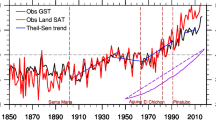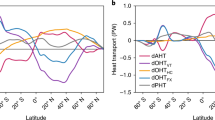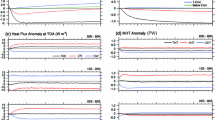Abstract
In this paper, we use a dry radiative-transportive climate model to illustrate that the atmospheric poleward heat transport plays an important role in amplifying the polar surface warming due to anthropogenic greenhouse gases. Because of a much warmer surface in tropics, the anthropogenic radiative forcing is larger in tropics than in extratropics for same amount of anthropogenic greenhouse gases. A direct response to the anthropogenic radiative forcing is an increase in the atmosphere equator-to-pole temperature contrast, leading to a strengthening of the atmospheric poleward heat transport. As a result, part of the extra amount of energy intercepted by the low-latitude atmosphere due to an increase in its opacity is transported to high latitudes. This implies a “greenhouse-plus” (“greenhouse-minus”) feedback to the high (low) latitude surface temperatures, which acts to amplify (reduce) the initial surface warming in high (low) latitudes and may cause a larger surface warming in high latitudes. The Stefan–Boltzmann feedback suppresses the negative dynamical feedback in low latitudes more strongly than the positive in high latitudes, amplifying the global mean surface temperature warming. Because of the oceanic poleward heat transport, the ocean surface temperature in extratropics is warmer in winter compared to the land, implying a larger radiative forcing for the same amount of anthropogenic greenhouse gases. The same dynamical feedback mechanism would also amplify the land surface warming in extratropics by transporting part of the extra amount of energy intercepted by the atmosphere over the ocean surface to land. This explains partly why the observed land surface warming in extratropics is stronger than the surrounding oceans in winter.









Similar content being viewed by others
Notes
One could use a more generic parameterization for D, \( D = \mu _{{\text{A}}} (A_{1} - A_{2} ){\left| {\frac{{A_{1} - A_{2} }} {{A_{1} + A_{2} }}} \right|}^{n} , \) where the non-dimensional parameter “n” measures the nonlinearity of the dynamic mixing. The scaling analysis suggests that meridional heat flux of baroclinic eddies is proportional to the square of the meridional temperature gradient (Held 1978a), which corresponds to n=1. Obviously, a different value of n would correspond to a different value of μ A for the same amount of the poleward heat transport, D. However, according to (2), the different values of n and μ A are not very relevant to the coupled radiative transportive model as long as they yield the same value of D. We have confirmed that for the same value of D, different values of n (n=0, 0.5, 1, 2, and 3 have been tested) essentially produce the same results. Therefore, it suffices that we only report the results obtained with n=0 in this paper.
Because all of the curves of constant μA≠0 have to intersect with the “curve of ε=0” (which actually is a point in the O–T diagram corresponding to the case of “no atmosphere” as far as the radiation is concerned), the slope of curves of constant μA is always smaller than those of constant emissivity. It follows that it suffices to just consider the polarity of the slope of curves of constant μA here.
References
Alexeev VA (2003) Sensitivity to CO2 doubling of an atmospheric GCM coupled to an oceanic mixed layer: a linear analysis. Clim Dyn 20:775–787
Alexeev VA, Langen PL, Bates JR (2005) Polar amplification of surface warming on an aquaplanet in “ghost forcing” experiments without sea ice feedbacks. Clim Dyn 24:655–666
Bates JB (1999) A dynamical stabilizer in the climate system: a mechanism suggested by a simple model. Tellus 51A:349–372
Boer GJ, Flato G, Reader NC, Ramsden D (2000) A transient climate change simulation with greenhouse gas and aerosol forcing. Clim Dyn 16:405–426
Budyko MI (1969) The effect of solar radiation variation on the climate of the earth. Tellus 21:611–619
Budyko MI, Izrael YA (1991) Anthropogenic climate change. The University of Arizona Press, pp 279–318
Comiso JC, Parkinson CL (2004) Satellite-observed changes in the Arctic. Phys Today 57:38–44
Hall A (2004) The role of surface albedo feedback in climate. J Clim 17:1550–1568
Hansen J, Ruedy R, Lacis A, Sato M, Nazarenko L, Tausnev N, Tegen I, Koch D (2000) Climate modelling in the global warming debate. In: Randall (ed) General circulation modeling: past, present and future. Academic, New York, pp 127–164
Hansen J, Ruedy R, Sato M, Imhoff M, Lawrence W, Easterling D, Peterson T, Karr T (2001) A close look at United States and global surface air temperature changes. J. Geophys Res 106:23947–23963
Hartmann DL (1994) Global physical climatology. Academic, New York, pp 231–245
Hassol SJ (2004) Impacts of a warming Arctic: Arctic climate impact assessment. Cambridge University Press, Cambridge, 146 pp
Held IM (1978a) The vertical scale of an unstable baroclinic wave and its importance for eddy heat flux parameterization. J Atmos Sci 35:572–576
Held IM (1978b) The tropospheric lapse rate and climate sensitivity: experiments with a two-level atmospheric model. J Atmos Sci 35:2083–2098
Held IM (1993) Large-scale dynamics and global warming. Bull Am Meteor Soc 74:228–241
Houghton JT et al (2001) Climate change 2001: the scientific basis. Cambridge University Press, Cambridge, pp 101–181
Jones PD, New M, Parker DE, Martin S, Rigor IG (1999) Surface air temperature and its changes over the past 150 years. Rev Geophys 37:173–199
Krabill W et al (2000) Greenland ice sheet: high-elevation balance and peripheral thinning. Science 289:428–430
Lindzen RS (1990) Dynamics in atmospheric physics. Cambridge University Press, Cambridge, pp 4–15
Manabe S (1983) Carbon dioxide and climate change. In: Saltzman B (ed) Theory of climate. Adv Geophys 25:39–80
Meehl GL, Washington WM, Arblaster JM, Bettge TW, Strand WG (2000) Anthropogenic forcing and decadal climate variability in sensitivity experiments of twentieth- and twenty-first century climate. J Clim 13:3728–3744
Meehl GL, Washington WM, Ammann CM, Arblaster JM, Wigley TML, Tebaldi C (2004) Combinations of natural and anthropogenic forcings in twentieth-century climate. J Climate 17:3721–3727
Mitchell JFB, Johns TC, Gregory JM, Tett SFB (1995) Climate response to increasing levels of greenhouse gases and sulphate aerosols. Nature 376:501–504
North GR (1975) Theory of energy-balance climate models. J Atmos Sci 32:2033–2043
Ohring G, Gruber A (1983) Satellite radiation observation and climate theory. In: Saltzman B (ed) Theory of climate. Adv Geophys 25:237–304
Schneider EK, Lindzen RL, Kirtman BP (1997) A tropical influence on global climate. J Atmos Sci 54:1349–1358
Sellers WD (1969) A climate model based on the energy balance of the earth-atmosphere system. J Appl Meteor 8:392–400
Vinnikov KY et al. (1999) Global warming and Northern Hemisphere sea ice extent. Science 286:1934–1937
Wingham DJ, Ridout AJ, Scharroo R, Arthern RJ, Shum CK (1998) Antarctic elevation change from 1992 to 1996. Science 282:456–458
Zwally HJ, Abdalati W, Herring T, Larson K, Saba J, Steffen K (2002) Surface melt-induced acceleration of Greenland ice-sheet flow. Science 297:218–222
Acknowledgements
The author is indebted to Huug M. van den Dool for his insightful comments and the suggestion of naming the model as a “radiative-transportive model”. The author is grateful to Eugenia Kalnay, F-F Jin, and Antonio Busalacchi for beneficial discussions and constructive suggestions. The insightful and constructive comments and suggestions from Jerry North and an anonymous reviewer, and the editor Ed Schneider are greatly appreciated. The author also thanks Minfeng Zhang for his assistance in plotting the numerical results and Shan Sun at GISS/NASA for her assistant in evaluating the GISS/NASA coupled model climate simulation output. This work was supported by an NSF grant ATM ATM-0403211.
Author information
Authors and Affiliations
Corresponding author
Rights and permissions
About this article
Cite this article
Cai, M. Dynamical greenhouse-plus feedback and polar warming amplification. Part I: A dry radiative-transportive climate model. Clim Dyn 26, 661–675 (2006). https://doi.org/10.1007/s00382-005-0104-6
Received:
Accepted:
Published:
Issue Date:
DOI: https://doi.org/10.1007/s00382-005-0104-6




